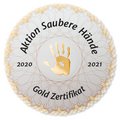Research
AG Bauer
Staff:
- AG director: Prof. Dr. Richard Bauer
- TA: Brigitta Hauer
- Doctoral candidate in life sciences: Karin Bauer
Our scientific research addresses the topic of cell-cell and cell-matrix adhesions in the progression of oral squamous cell carcinoma. We are studying two types of proteins which play a role in the formation of tumours. One type involves transmembrane, calcium-dependent cell-cell adhesion molecules, such as cadherins, which are responsible for binding cells to other cells and maintaining the epithelial architecture. Our research into oral squamous cell carcinoma focuses on the erroneous expression and processing of P-cadherin during progression of the tumour. We are also examining the misdirected cellular signalling pathways that accompany this and their influence on the development of the tumour. The other type of protein we are analysing involves erroneously secreted proteins that have a negative effect on the behaviour of tumour cells in the tumour’s microenvironment. This leads to increased migration, invasiveness or enhanced proliferation, for example. Truncated forms and the erroneous expression of P-cadherin or FACIT collagen XVI play a role in the proliferation and invasion of degenerated keratinocytes.
-
So far, our results show that the loss of full-length P-cadherin and truncated forms of this membrane protein play a key functional role in the de-differentiation of oral keratinocytes. In addition, a truncated 50 kDa variant had a significant impact on the migration and invasion of oral squamous cell carcinoma cells and malignant melanocytes. It was possible to demonstrate that P-cadherin influences the signalling pathways, which enable a recycling of de-differentiated keratinocytes into differentiated epithelial cell types.
In the course of tumour progression, patients with oral squamous cell carcinoma lose transmembrane P-cadherin. Both in vivo and in vitro, it was possible to demonstrate that truncation of P-cadherin occurs during tumour formation in the oral squamous epithelium. A 50 kDa fragment was detected in cell lysates and in the supernatant of malignant oral keratinocytes. Differentiated cells showing a keratinocyte-specific cytokeratin expression profile still simultaneously expressed full-length P-cadherin. However, de-differentiated cells showed only the truncated form of P-cadherin. After treatment of the cells with a soluble, recombinantly manufactured 50 kDa P-cadherin fragment, this weakened the tissue integrity. Separation of the cells was stimulated and their migration was enabled. In our research group, we explore, amongst other things, what effect the transduction of P-cadherin has on originally cadherin-deficient cells from the oral squamous cell carcinoma. Using the experiments conducted, we analysed which signalling pathways are controlled by P-cadherin. This revealed that an induction of the P-cadherin expression in degenerated keratinocytes leads from a mesenchymal to an epithelial transduction. This was macroscopically visible by the fact that the cells assumed an epithelium-like, cobblestone-like morphology. On the molecular level, the epithelial transformation was achieved by inactivating the kinase GSK-3beta and the subsequent snail phosphorylation. The kinase integrates directly with the snail that is translocated from the nucleus. Because the snail is a repressor of E-cadherin, there was a re-expression of E-cadherin on the mRNA level. Full-length P-cadherin in oral squamous cell carcinoma cells also causes beta-Catenin to be translocated from the nucleus to the membrane, and the vitronectin expression is reduced, which also indicates a molecular epthelial-mesenchmyal transduction.
-
We are also studying changes to the cell-matrix adhesion in oral squamous cell carcinoma. Collagen XVI seems to play a role in this. This protein is a FACIT-collagen (fibril associated collagen with interrupted triple helix). In the skin and oral mucosa, this protein is found in the junction zone between the dermis and the epidermis. Here, it plays a part in the integrity of the basal membrane and the network of elastic fibrils. Collagen XVI is formed from fibroblasts and keratinocytes and can integrate with cell-matrix receptors, the alpha 1 and alpha 2 integrins. By performing immunofluorescence staining on paraffin sections, we were able to demonstrate that collagen XVI is strongly expressed in keratinocytes of the upper epithelial layers in patients with oral squamous cell carcinoma. In stably transfected cell clones, an induction of the expression of the integrin-associated protein Kindlin-1 appeared after overexpression of collagen XVI in the oral squamous cell carcinoma cell line PCI13. In addition, increased interaction of this protein with integrins was detected. At the same time, flow-cytometric analyses proved that the activity of integrins was significantly increased after overexpression of collagen XVI in aberrant keratinocytes. Cell cycle analyses revealed that cells overexpressing collagen XVI enter the S-phase of the cell cycle prematurely and show increased proliferation activity. Also, after a certain period of time, overexpressing collagen XVI cells proved to be more invasive than control cells without collagen XVI expression. So far, our studies on collagen XVI prove that after excessive expression in the area surrounding degenerated cells, these cells demonstrate a more aggressive phenotype.
-
1: Dowejko A, Bauer R, Bauer K, Müller-Richter UD, Reichert TE. The human HECA interacts with cyclins and CDKs to antagonize Wnt-mediated proliferation and chemoresistance of head and neck cancer cells. Exp Cell Res. 2011 Nov 10. [Epub ahead of print] PubMed PMID: 22100912.
2: Bauer K, Dowejko A, Bosserhoff AK, Reichert TE, Bauer R. Slit-2 facilitates interaction of P-cadherin with Robo-3 and inhibits cell migration in an oral squamous cell carcinoma cell line. Carcinogenesis. 2011 Jun;32(6):935-43. Epub 2011 Mar 31. PubMed PMID: 21459757.
3: Bauer R, Ratzinger S, Wales L, Bosserhoff A, Senner V, Grifka J, Grässel S. Inhibition of collagen XVI expression reduces glioma cell invasiveness. Cell Physiol Biochem. 2011;27(3-4):217-26. Epub 2011 Apr 1. PubMed PMID: 21471710.
4: Ratzinger S, Grässel S, Dowejko A, Reichert TE, Bauer RJ. Induction of type XVI collagen expression facilitates proliferation of oral cancer cells. Matrix Biol. 2011 Mar;30(2):118-25. Epub 2011 Jan 18. PubMed PMID: 21251976.
5: Bauer K, Dowejko A, Bosserhoff AK, Reichert TE, Bauer RJ. P-cadherin induces an epithelial-like phenotype in oral squamous cell carcinoma by GSK-3beta-mediated Snail phosphorylation. Carcinogenesis. 2009 Oct;30(10):1781-8. Epub 2009 Jul 14. PubMed PMID: 19654099.
6: Dowejko A, Bauer RJ, Müller-Richter UD, Reichert TE. The human homolog of the Drosophila headcase protein slows down cell division of head and neck cancer cells. Carcinogenesis. 2009 Oct;30(10):1678-85. Epub 2009 Jul 30. PubMed PMID: 19643820.
7: Driemel O, Müller-Richter UD, Hakim SG, Bauer R, Berndt A, Kleinheinz J, Reichert TE, Kosmehl H. Oral acantholytic squamous cell carcinoma shares clinical and histological features with angiosarcoma. Head Face Med. 2008 Jul 31;4:17. PubMed PMID: 18671846; PubMed Central PMCID: PMC2515303.
8: Bauer R, Dowejko A, Driemel O, Bosserhoff AK, Reichert TE. Truncated P-cadherin is produced in oral squamous cell carcinoma. FEBS J. 2008 Aug;275(16):4198-210. Epub 2008 Jul 11. PubMed PMID: 18637117.
9: Morsczeck C, Ernst W, Florian C, Reichert TE, Proff P, Bauer R, Müller-Richter U, Driemel O. Gene expression of nestin, collagen type I and type III in human dental follicle cells after cultivation in serum-free medium. Oral Maxillofac Surg. 2008 Jul;12(2):89-92. Epub 2008 Jun 3. PubMed PMID: 18618166.
10: Bauer R, Bosserhoff AK. Functional implication of truncated P-cadherin expression in malignant melanoma. Exp Mol Pathol. 2006 Dec;81(3):224-30. Epub 2006 Aug 17. PubMed PMID: 16919267.
11: Driemel O, Berndt A, Hartmann A, Mueller-Richter UD, Bauer R, Reichert TE, Kosmehl H. [Clinical and immunohistochemical findings of intra- and extraoral angiosarcomas]. Mund Kiefer Gesichtschir. 2006 Jul;10(4):239-47. German. PubMed PMID: 16788797.
12: Bauer R, Wild PJ, Meyer S, Bataille F, Pauer A, Klinkhammer-Schalke M, Hofstaedter F, Bosserhoff AK. Prognostic relevance of P-cadherin expression in melanocytic skin tumours analysed by high-throughput tissue microarrays. J Clin Pathol. 2006 Jul;59(7):699-705. Epub 2006 Mar 24. PubMed PMID: 16565225; PubMed Central PMCID: PMC1860409.
13: Kuphal S, Bauer R, Bosserhoff AK. Integrin signaling in malignant melanoma. Cancer Metastasis Rev. 2005 Jun;24(2):195-222. Review. PubMed PMID: 15986132.
14: Bauer R, Hein R, Bosserhoff AK. A secreted form of P-cadherin is expressed in malignant melanoma. Exp Cell Res. 2005 May 1;305(2):418-26. PubMed PMID: 15817166.








